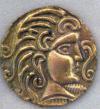What Can a Dinosaur’s Inner Ear Tell Us? Just Listen

If paleontologists had a wish list, it would almost certainly include insights into two particular phenomena: how dinosaurs interacted with each other and how they began to fly.
The problem is, using fossils to deduce such behavior is a tricky business. But a new, Yale-led study offers a promising entry point — the inner ear of an ancient reptile.
Hesperornis image provided by the Yale Peabody Museum of Natural History.
According to the study, the shape of the inner ear offers reliable signs as to whether an animal soared gracefully through the air, flew only fitfully, walked on the ground, or sometimes went swimming. In some cases, the inner ear even indicates whether a species did its parenting by listening to the high-pitched cries of its babies.
“Of all the structures that one can reconstruct from fossils, the inner ear is perhaps that which is most similar to a mechanical device,” said Yale paleontologist Bhart-Anjan Bhullar, senior author of the new study, published in the journal Science.
“It’s so entirely dedicated to a particular set of functions. If you are able to reconstruct its shape, you can reasonably draw conclusions about the actual behavior of extinct animals in a way that is almost unprecedented,” said Bhullar, who is an assistant professor of earth and planetary sciences in the Faculty of Arts and Sciences and an assistant curator at the Yale Peabody Museum of Natural History.
Working with colleagues at the American Museum of Natural History, Bhullar and first author Michael Hanson of Yale compiled a matrix of inner ear data for 128 species, including modern-day animals such as birds and crocodiles, along with dinosaurs such as Hesperornis, Velociraptor, and the pterosaur Anhanguera.
Hesperornis, an 85-million-year-old bird-like species that had both teeth and a beak, was the inspiration for the research. The Yale Peabody Museum of Natural History has the world’s only three-dimensional fossil that preserves a Hesperornis inner ear.A troodontid dinosaur parent glides down to its nest, using its specialized vestibular system to coordinate its landing and its elongated cochlea to hear its babies’ chirps.
“I was aware of literature associating cochlear dimensions with hearing capability, and semicircular canal structure with locomotion in reptiles and birds, so I became curious as to how Hesperornis would fit into the picture,” said Hanson, a graduate student at Yale.
Hanson and Bhullar analyzed the Hesperornis inner ear with CT scanning technology to determine its three-dimensional shape.
Next, the researchers conducted the same analysis with a variety of other fossils — and current species — to determine whether the inner ear provided strong indications of behavior. In many cases, the researchers created 3D models from crushed or partially-crushed skull fossils.
After assembling the data, the researchers found clusters of species with similar inner ear traits. The clusters, they said, correspond with the species’ similar ways of moving through and perceiving the world.
Several clusters were the result of the structure of the top portion of the inner ear, called the vestibular system. This, said Bhullar, is “the three-dimensional structure that tells you about the maneuverability of the animal. The form of the vestibular system is a window into understanding bodies in motion.”
One vestibular cluster corresponded with “sophisticated” fliers, species with a high level of aerial maneuverability. This included birds of prey and many songbirds.
Another cluster centered around “simple” fliers like modern fowl, which fly in quick, straight bursts, and soaring seabirds and vultures. Most significantly, the inner ears of birdlike dinosaurs called troodontids, pterosaurs, Hesperornis, and the “dino-bird” Archaeopteryx fall within this cluster.
The researchers also identified a cluster of species which had a similar elongation of the lower portion of the inner ear — the cochlear system — that has to do with hearing range. This cluster featured a fairly large group of species, including all modern birds and crocodiles, which together form a group called archosaurs, the “ruling reptiles.”
Bhullar said the data suggest that the cochlear shape’s transformation in ancestral reptiles coincided with the development of high-pitched location, danger, and hatching calls in juveniles.
It implies that adults used their new inner ear feature to parent their young, the researchers said.
“All archosaurs sing to each other and have very complex vocal repertoires,” Bhullar said. “We can reasonably infer that the common ancestors of crocodiles and birds also sang. But what we didn’t know was when that occurred in the evolutionary line leading to them. We’ve discovered a transitional cochlea in the stem archosaur Euparkeria, suggesting that archosaur ancestors began to sing when they were swift little predators a bit like reptilian foxes.”
Co-authors of the study are Mark Norell and Eva Hoffman of the American Museum of Natural History.
The Yale Department of Earth & Planetary Sciences, the Yale Institute for Biospheric Studies, the American Museum of Natural History, and the National Science Foundation funded the research.
Contacts and sources:
Jim Shelton
Yale University
Source: http://www.ineffableisland.com/2021/05/what-can-dinosaurs-inner-ear-tell-us.html
Anyone can join.
Anyone can contribute.
Anyone can become informed about their world.
"United We Stand" Click Here To Create Your Personal Citizen Journalist Account Today, Be Sure To Invite Your Friends.
Please Help Support BeforeitsNews by trying our Natural Health Products below!
Order by Phone at 888-809-8385 or online at https://mitocopper.com M - F 9am to 5pm EST
Order by Phone at 866-388-7003 or online at https://www.herbanomic.com M - F 9am to 5pm EST
Order by Phone at 866-388-7003 or online at https://www.herbanomics.com M - F 9am to 5pm EST
Humic & Fulvic Trace Minerals Complex - Nature's most important supplement! Vivid Dreams again!
HNEX HydroNano EXtracellular Water - Improve immune system health and reduce inflammation.
Ultimate Clinical Potency Curcumin - Natural pain relief, reduce inflammation and so much more.
MitoCopper - Bioavailable Copper destroys pathogens and gives you more energy. (See Blood Video)
Oxy Powder - Natural Colon Cleanser! Cleans out toxic buildup with oxygen!
Nascent Iodine - Promotes detoxification, mental focus and thyroid health.
Smart Meter Cover - Reduces Smart Meter radiation by 96%! (See Video).





